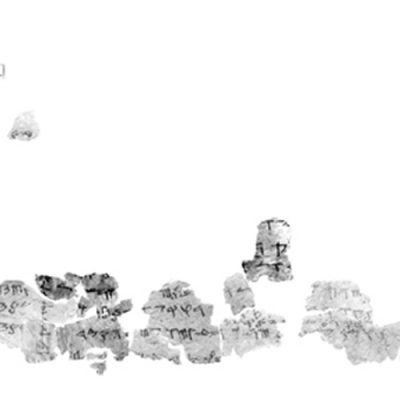
 Dr. Eshbal Ratson and Prof. Jonathan Ben-Dov of the University of Haifa have managed to decipher and restore one of the last two Qumran Scrolls that remain unpublished.
Dr. Eshbal Ratson and Prof. Jonathan Ben-Dov of the University of Haifa have managed to decipher and restore one of the last two Qumran Scrolls that remain unpublished.
Most of the 900 Qumran Scrolls discovered in the 1940s and 1950s have been restored and published. The tiny remaining fragments, some smaller than one square centimeter [0.155 sq in], included some 60 sections written in secret code on parchment.
The members of the Qumran sect, who referred to themselves as the Yahad—Together Community—were a group that lived a hermitic life in the desert and faced persecution by the dominant establishment of the time. The sect followed a 364-day calendar which was involved in one of the fiercest debates between different groups during the late Second Temple period.
“The lunar calendar, which Judaism follows to this day, requires a large number of human decisions. People must look at the stars and moon and report on their observations, and someone must be empowered to decide on the new month and the application of leap years. By contrast, the 364-day calendar was perfect. Because this number can be divided into four and seven, special occasions always fall on the same day. This avoids the need to decide, for example, what happens when a particular occasion falls on the Sabbath, as often happens in the lunar calendar. The Qumran calendar is unchanging, and it appears to have embodied the beliefs of the members of this community regarding perfection and holiness,” the researchers explained.
The scroll describes two special occasions not mentioned in the Bible, but which are already known from the Temple Scroll of Qumran: the festivals of New Wine and New Oil. They constituted an extension of the festival of Shavuot which celebrates the New Wheat. According to this calendar, the festival of New Wheat falls 50 days after the first Sabbath following Passover; the festival of New Wine comes 50 days later; and after a further interval of 50 days, the festival of New Oil is celebrated.
The members of the sect celebrated the transition between the seasons, adding a special day for each of the four changes of season. Until now, the name of these special days was unknown. The present scroll reveals that these days were referred to as Tekufah, translated as “period.”
Source: Excerpts from an article by Edgar Asher, Ashernet
Photo Credit: IAA/Ashernet
All logos and trademarks in this site are property of their respective owner. All other materials are property of Bridges for Peace. Copyright © 2025.
Website Site Design by J-Town Internet Services Ltd. - Based in Jerusalem and Serving the World.